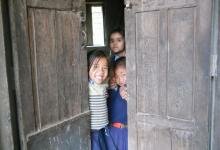Picture, Reality
Between February and March 2011, with the support of The Patatas, I conducted a photography workshop with some 34 students in Nepal, most of which were from underprivileged backgrounds. During the month-long course, students kept a journal of the lessons they learnt and the reflections they experienced. This is an excerpt from the journal of one of my students, Suman Shakya.

By Suman Shakya
22 February: Since my childhood I've had an interest in photography. When I was about 11 years old, I went for a picnic with my family where my uncle brought a camera and he taught me to take photographs. Actually, he is not a professional photographer. Since that day, I've loved taking photos. When I go on outings with my friends, I love to take photos of them. They even give me some good and bad comments on my photographs.
I always have a dream to have a good trainer and camera. Now, I think I got that. I am very happy to participate in this photography training, and to have a teacher like Debby. I am expecting that I could develop my photography skills after the training.
23 February: With a cup of tea I start to think of where I can move for my assignment. The day was very clear. I was loving the weather. With the brand new camera, I came out of the house then began to take pictures by using many options in the camera. Playing around with the options made a lot of difference. Finally, I feel shy to take pictures amongst the people, but later on I felt normal. I got what Debby meant about the difference between the lens of our eye and the lens of a camera, it's not the same. I couldn't take the photos that I really want to take. The photo output and my training didn't match. I leave this problem and again I start to click another movement.
24 February: In the early morning, I went to Swyambhu temple to take some photos. The weather was quite good. I loved the peaceful environment of Swyambhu. There I tried to take photos in different angles. Still, the same problem occurred - the image I captured didn't match with my thinking. I took many photos of many temples and monkeys. It was really fun when I captured the activities of the monkeys.
26 February: I think this day may be one of the most memorable days. I went to the Nuwakot district with my friends. There we saw beautiful landscapes and wonderful sunset views. We took lots of photos there, even videos. We were at the top of the hill, enjoying the views. The smooth cold wind was blowing on our face while we viewed the hills below. It was neither hot nor cold.
At that place I got the chance to learn many things about photography. I enjoyed using macro effect and exposure effects in the camera. It was really fun when we took pictures of rays of sunlight passing through the holes in the thick clouds in the evening. The colour was really beautiful and amazing. The sun set view was also incredible. The colour of the sun was so dark red. The clouds had the same colour too. The view was really beautiful. But unfortunately, the battery of my camera ran out and I was not able to take photos.
3 March: It was our fourth class. We discussed simple story telling with pictures, it was really inspiring. In the photos the objects have something to say. The pictures shown spoke for themselves.
After the presentation I start to wonder why the pictures that are shown were so nice and I think it is because they were very simple. The background was clear, the pictures taken were balanced and they all had a simple story to tell.

10 March: Today I made plans to go to a stone mine in Echangu where I can capture photos for my assignment about people and their environment. I think it will be an appropriate environment for my subject. It was about 6km away from my place. It is one of the big sources of stone in the city Over there, stones are broken down into small gravel which supply the towns for building different structures.
As I reach the place, I can hear the noise of breaking stones. I saw there are about 50 people working, even small children are involved.
The people look very poor, they don't have good health, food, cloth, shelter. The children playing on the stones have no future. They are living a really a hard life. They seem to just be surviving but not living a life.



 Debby Ng forayed into journalism following failed attempts at becoming a world-class equestrian. A wildlife crime investigator, underwater photographer, dive master and founder of a marine conservation organisation, she spends what remains of her time writing about the environment, its wildlife, and its people.
Debby Ng forayed into journalism following failed attempts at becoming a world-class equestrian. A wildlife crime investigator, underwater photographer, dive master and founder of a marine conservation organisation, she spends what remains of her time writing about the environment, its wildlife, and its people.













